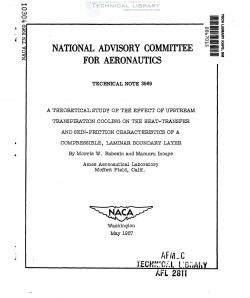naca-tn-3969
- Version
- 116 Downloads
- 1.58 MB File Size
- 1 File Count
- January 29, 2017 Create Date
- January 29, 2017 Last Updated
National Advisory Committee for Aeronautics, Technical Notes - A Theoretical Study of the Effect of Upstream Transpiration Cooling on the Heat Transfer and Skin Friction Characteristics of a Compressible, Laminar Boundary Layer

An analysis is presented which predicts the skin-friction and heat-
transfer characteristics of a compressible, laminar boundary layer on a
solid flat plate preceded by a porous section.that is transpiration cooled.
The anahysis is restricted to a Prandtl number of unity and linear
variation of viscosity with temperature.
The local skin friction has been found to have a low value in the
region of transpiration cooling and then to increase until it approaches
the value for a completely nonporous surface asymptotically. The initial
increase in local skin friction is rapid as half of the ultimate increase
occurs in a distance beyond the porous region that is about 20 percent of
the length of the porous region for all rates of injection. When the
total coolant flow rate is kept constant and the porous length is varied,
it is found that the average skin friction on a partially porous plate is
slightly lower than that on a fully porous plate.
The local heat transfer behaves in a manner similar to that of the
local skin friction. It is found, in an example, that the temperature
at the end of a partially porous plate could be maintained at about the
same temperature as a fully porous plate by doubling the total rate of
coolant flow.
For flight at high speeds, aerodynamic heating often requires the
cooling of aircraft in order to maintain tolerable surface temperatures.
Of the various cooling techniques available, transpiration cooling systems
are usually effective for this application, as is shown in reference 1.
This results because the geometry of the porous surface provides for
excellent heat exchange between the coolant and the surface, and the
boundary layer on the surface is altered so as to reduce significantly
the skin friction and the heat transfer to the surface.
The attractiveness of transpiration cooling of large surfaces is
reduced by the introduction of structural problems. It is difficult to
manufacture large porous surfaces and to support them in use because of
their inherent weakness. To take advantage of transpiration cooling and
also to alleviate the structural problems, the use of partially porous
surfaces offers possibilities. In this scheme, the most critical regions
from an aerodynamic heating standpoint could be transpiration cooled, and
the downstream regions protected by the film of coolant that is introduced
into the boundary layer.
| File | Action |
|---|---|
| naca-tn-3969 A Theoretical Study of the Effect of Upstream Transpiration Cooling on the Heat Transfer and Skin Friction Characteristics of a Compressible, Laminar Boundary Layer.pdf | Download |

Comment On This Post